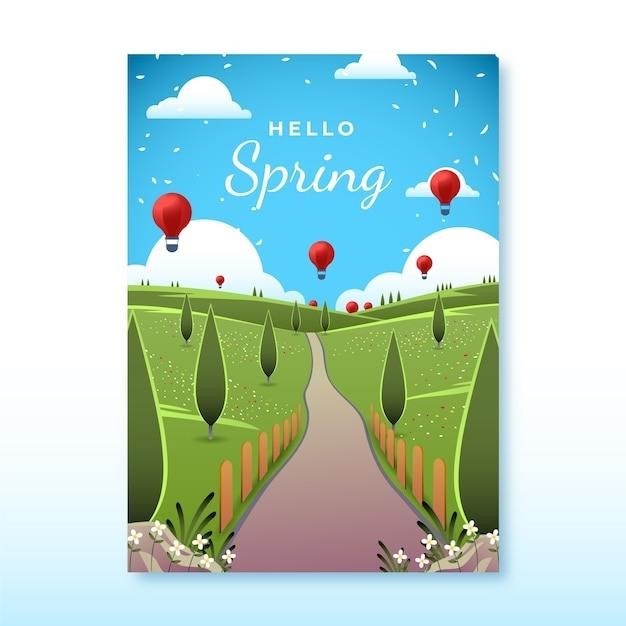the wind in the willows book pdf

The Wind in the Willows Book PDF⁚ A Comprehensive Guide
This guide delves into Kenneth Grahame’s beloved classic, “The Wind in the Willows,” offering a comprehensive look at its history, plot, characters, themes, and enduring appeal. We’ll explore its critical reception, numerous adaptations, and provide insights into where you can find the book in PDF format. Get ready to embark on a journey through the enchanting world of Toad, Mole, Rat, and Badger, and discover why this timeless tale continues to captivate readers of all ages.
Introduction
“The Wind in the Willows” is a cherished classic of children’s literature that has captivated generations with its whimsical charm and timeless themes. Written by Kenneth Grahame and first published in 1908, the book tells the story of four animal friends—Toad, Mole, Rat, and Badger—who live in the idyllic English countryside. Their adventures, filled with laughter, friendship, and a touch of danger, resonate with readers of all ages. The Wind in the Willows” has been adapted countless times for stage, screen, and radio, cementing its place in popular culture. The book’s enduring popularity is a testament to its universal appeal, offering a delightful escape into a world of imagination and wonder. This comprehensive guide delves into the book’s history, plot, characters, themes, and critical reception, exploring why it continues to be a beloved classic. We’ll also provide insights into where you can find “The Wind in the Willows” in PDF format, making it easier than ever to rediscover this timeless treasure.
History and Author
“The Wind in the Willows” was born from the imagination of Kenneth Grahame, a British author and essayist known for his lyrical prose and keen observation of nature. Grahame, born in 1859, spent his childhood in Edinburgh and later worked as a banker in London. His early literary endeavors focused on essays and short stories, but it was his fascination with the natural world and his love for his son, Alastair, that ultimately led him to write “The Wind in the Willows.” The book’s origins can be traced back to stories Grahame told his son, drawing inspiration from their walks along the River Thames and their shared love of the English countryside. Originally published in 1908, “The Wind in the Willows” was an instant success, capturing the hearts of readers with its whimsical characters and heartwarming adventures. Grahame’s meticulous attention to detail, his ability to create relatable animal characters, and his lyrical prose continue to make the book a timeless classic. The story’s enduring appeal lies in its ability to transport readers to a world of imagination and wonder, reminding us of the simple joys of friendship, adventure, and the beauty of the natural world.
Plot Summary
“The Wind in the Willows” follows the adventures of four animal friends who inhabit the idyllic English countryside⁚ Mole, the simple and kind-hearted protagonist; Rat, the wise and adventurous water rat; Badger, the gruff but loyal patriarch; and Toad, the impulsive and self-absorbed character who drives much of the story’s action. The story begins with Mole’s spring cleaning, a task that leads him to discover the joys of life beyond his underground home. He meets Rat, who introduces him to the River and its wonders, embarking on boat trips and exploring the surrounding meadows. Their idyllic existence is disrupted by Toad’s arrival, who, consumed by a passion for motorcars, causes chaos with his reckless driving and ultimately lands himself in prison. Mole, Rat, and Badger embark on a series of daring rescues to free Toad, navigating through the Wild Wood, encountering its menacing inhabitants, and facing numerous challenges along the way. Through their adventures, the friends learn valuable lessons about friendship, responsibility, and the importance of staying true to oneself. The story culminates with Toad’s eventual redemption, as he finds a new passion in the world of gardening, ultimately realizing the true meaning of happiness.
Characters
The Wind in the Willows features a memorable cast of animal characters, each representing distinct personality traits and embodying universal human experiences. Mole, the gentle and amiable protagonist, embodies innocence and the joy of discovery. Rat, the wise and resourceful water rat, represents practicality and a love for nature. Badger, the gruff but loyal patriarch, embodies wisdom, strength, and a protective nature. Toad, the impulsive and self-absorbed character, represents the human tendency for recklessness and the pursuit of fleeting desires. These characters are not merely animals but complex individuals who grapple with emotions, desires, and moral dilemmas. Their interactions are both humorous and heartwarming, highlighting the importance of friendship, loyalty, and acceptance. The story’s success lies in its ability to humanize its animal characters, allowing readers to relate to their experiences and learn valuable lessons through their journeys.
Themes
The Wind in the Willows explores a multitude of themes that resonate with readers of all ages. At its core, the story celebrates the power of friendship and the importance of loyalty. The unwavering bonds between Mole, Rat, Badger, and even the often-troubled Toad serve as a testament to the enduring strength of true companionship. The novel also delves into themes of self-discovery and personal growth. Mole’s journey from his solitary existence to his newfound friendships and adventures reflects the transformative power of embracing new experiences and connections. The story further touches upon the dangers of unchecked ambition and the importance of accepting one’s limitations. Toad’s relentless pursuit of self-indulgent pleasures and his disregard for consequences serve as a cautionary tale about the consequences of unbridled impulsivity. Ultimately, The Wind in the Willows emphasizes the importance of finding balance between individual desires and the needs of those around us, highlighting the beauty and fragility of the natural world and the profound impact it has on our lives.
Critical Reception
Upon its release in 1908, “The Wind in the Willows” received mixed critical reception. While some reviewers praised its whimsical charm and enchanting prose, others found it overly sentimental and lacking in depth. However, the book’s enduring popularity has solidified its place as a classic of children’s literature. Critics have lauded its timeless appeal, its ability to evoke a sense of wonder and nostalgia, and its exploration of universal themes that resonate with readers of all ages. The novel’s enduring popularity can be attributed to its whimsical characters, its charming depiction of the English countryside, and its exploration of universal themes such as friendship, self-discovery, and the importance of nature. “The Wind in the Willows” has been praised for its lyrical prose, its vivid descriptions of the natural world, and its ability to capture the spirit of childhood adventure. The book has also been recognized for its enduring themes, which continue to resonate with readers today.
Adaptations
“The Wind in the Willows” has inspired numerous adaptations across various mediums, showcasing its enduring popularity and its ability to translate seamlessly into different formats. The book has been adapted for the stage, screen, and radio, with each iteration capturing the essence of Grahame’s beloved characters and their adventures. One of the most notable adaptations is the 1983 animated film “The Wind in the Willows,” produced by “The Wind in the Willows” has also been adapted into several television series, including a 1995 animated series for children and a 2006 live-action series for adults. In addition to its screen adaptations, “The Wind in the Willows” has been adapted into numerous stage productions, including a 1974 musical adaptation by The book has also been adapted into numerous other formats, including opera, ballet, and even a video game. The enduring popularity of “The Wind in the Willows” is evident in its numerous adaptations, which continue to introduce new generations to the enchanting world of Toad, Mole, Rat, and Badger.
Where to Find the PDF

Finding a PDF version of “The Wind in the Willows” is surprisingly easy, thanks to its status as a public domain work. Many online sources offer free downloads of the book in PDF format. Websites dedicated to classic literature, such as Project Gutenberg, provide digital versions of public domain works, including “The Wind in the Willows.” You can also find the book available for download on various eBook platforms, such as Amazon Kindle, where you can purchase or download a free version. Additionally, several websites offer free PDF downloads of “The Wind in the Willows” without requiring registration. These websites often provide links to various ebook formats, including PDF, EPUB, and MOBI, offering a convenient way to access the book on different devices. However, always ensure the source is reputable and the PDF is free of any malware or viruses before downloading.
Reading Tips
While “The Wind in the Willows” is a classic children’s book, its charm transcends age. Here are some tips to enhance your reading experience, whether you’re revisiting the story or reading it for the first time⁚ Embrace the whimsical nature of the narrative. Let yourself be swept away by the fantastical world of talking animals and their adventures. Pay attention to the beautiful prose. Grahame’s writing is lyrical and evocative, painting vivid pictures with his words. Take your time to savor the descriptions of the English countryside and the characters’ personalities. Consider reading aloud. The book’s rhythm and rhyme make it ideal for reading aloud, whether to yourself, a child, or a group of friends. Reading aloud can bring the story to life and enhance its charm. Don’t rush through the story. Allow yourself to get lost in the world of “The Wind in the Willows.” There’s no need to hurry; let the characters and their adventures unfold at their own pace. Enjoy the simple pleasures of the story. The book celebrates friendship, adventure, and the beauty of nature. Take time to appreciate these themes as you read.
The Wind in the Willows in Popular Culture
“The Wind in the Willows” has left an indelible mark on popular culture, inspiring countless adaptations and references that continue to delight audiences of all ages. The book’s enduring popularity has led to its frequent inclusion in school curricula and its adaptation into numerous stage productions, films, television series, and even video games. One of the most beloved adaptations is the 1983 animated film “The Wind in the Willows,” which captures the essence of the story with charming visuals and memorable songs. The characters of Toad, Mole, Rat, and Badger have become iconic figures in children’s literature, with their personalities and quirks often referenced in popular culture. The book’s themes of friendship, adventure, and the joys of nature have resonated with audiences across generations, ensuring its continued relevance in the modern world. From classic cartoons to contemporary memes, “The Wind in the Willows” continues to inspire and entertain, proving that its timeless charm knows no bounds.
The Enduring Appeal
The enduring appeal of “The Wind in the Willows” lies in its timeless themes and charming characters. The book’s celebration of friendship and the joys of nature resonates with readers of all ages. The adventures of Toad, Mole, Rat, and Badger provide a sense of escapism and wonder, transporting readers to a world of idyllic countryside and exciting escapades. Grahame’s masterful storytelling weaves together elements of humor, adventure, and gentle wisdom, creating a narrative that is both engaging and heartwarming. The book’s focus on the simple pleasures of life, such as exploring the riverbank, enjoying a good meal, and spending time with loved ones, speaks to a universal yearning for connection and contentment. “The Wind in the Willows” is a testament to the power of imagination and the enduring appeal of classic literature, reminding us of the importance of friendship, adventure, and the beauty of the natural world.
“The Wind in the Willows” stands as a testament to the enduring power of classic literature, a tale that has captivated generations with its enchanting characters, timeless themes, and heartwarming narrative. The book’s exploration of friendship, adventure, and the beauty of nature continues to resonate with readers of all ages, reminding us of the simple joys that enrich our lives. Whether you’re revisiting this beloved classic or discovering it for the first time, “The Wind in the Willows” offers a journey of escapism, wonder, and profound human connection. The book’s enduring popularity is a testament to Grahame’s masterful storytelling and the timeless appeal of his characters, ensuring that Toad, Mole, Rat, and Badger will continue to charm and inspire readers for generations to come. So, delve into the world of “The Wind in the Willows” and experience the magic for yourself.



Leave a Reply
You must be logged in to post a comment.